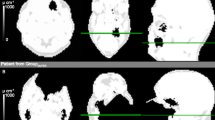Abstract
Objective
The objective of this study was to investigate the effects of computed tomography (CT) artifacts caused by dental metal prostheses on positron emission tomography (PET) images.
Methods
A dental arch cast was fixed in a cylindrical water-bath phantom. A spherical phantom positioned in the vicinity of the dental arch cast was used to simulate a tumor. To simulate the tumor imaging, the ratio of the 18F-fluoro-deoxy-glucose radioactivity concentration of the spherical phantom to that of the water-bath phantom was set at 2.5. A dental bridge composed of a gold–silver–palladium alloy on the right mandibular side was prepared. A spherical phantom was set in the white artifact area on the CT images (site A), in a slightly remote area from the white artifact (site B), and in a black artifact area (site C). A PET/CT scan was performed with and without the metal bridge at each simulated tumor site, and the artifactual influence was evaluated on the axial attenuation-corrected (AC) PET images, in which the simulated tumor produced the strongest accumulation. Measurements were performed using three types of PET/CT scanners (scanners 1 and 2 with CT-based attenuation correction, and 3 with Cesium-137 (137Cs)-based attenuation correction). The influence of the metal bridge was evaluated using the change rate of the SUVmean with and without the metal bridge.
Results
At site A, an overestimation was shown (scanner 1: +5.0% and scanner 2: +2.5%), while scanner 3 showed an underestimation of −31.8%. At site B, an overestimation was shown (scanner 1: +2.1% and scanner 2: +2.0%), while scanner 3 showed an underestimation of −2.6%. However, at site C, an underestimation was shown (scanner 1: −25.0%, scanner 2: −32.4%, and scanner 3: −8.4%).
Conclusions
When CT is used for attenuation correction in patients with dental metal prostheses, an underestimation of radioactivity of accumulated tracer is anticipated in the dark streak artifact area on the CT images. In this study, the dark streak artifacts of the CT caused by metallic dental prostheses may cause false negative finding of PET/CT in detecting small and/or low uptake tumor in the oral cavity.





Similar content being viewed by others
References
Kinahan PE, Hasegawa BH, Beyer T. X-ray-based attenuation correction for positron emission tomography/computed tomography scanners. Semin Nucl Med. 2003;33:166–79.
Halpern BS, Dahlbom M, Waldherr C, Yap CS, Schiepers C, Silverman DH, et al. Cardiac pacemakers and central venous lines can induce focal artifacts on CT-corrected PET images. J Nucl Med. 2004;45:290–3.
Bujenovic S, Mannting F, Chakrabarti R, Ladnier D. Artifactual 2-deoxy-2-(18F)fluoro-d-glucose localization surrounding metallic objects in a PET/CT scanner using CT-based attenuation correction. Mol Img Biol. 2003;5:20–2.
Goerres GW, Hany TF, Kamel E, von Schulthess GK, Buck A. Head and neck imaging with PET and PET/CT: artefacts from dental metallic implants. Eur J Nucl Med. 2002;29:367–70.
Goerres GW, von Schulthess GK, Hany TF. Positron emission tomography and PET CT of the head and neck: FDG uptake in normal anatomy, in benign lesions, and in changes resulting from treatment. Am J Roentgenol. 2002;179:1337–43.
Kamel EM, Burger C, Buck A, von Schulthess GK, Goerres GW. Impact of metallic dental implants on CT-based attenuation correction in a combined PET/CT scanner. Eur Radiol. 2003;13:724–8.
Goerres GW, Schmid DT, Eyrich GK. Do hardware artefacts influence the performance of head and neck PET scans in patients with oral cavity squamous cell cancer? Dentomaxillofacial Radiol. 2003;32:365–71.
Schäfers KH, Raupach R, Beyer T. Combined 18F-FDG-PET/CT imaging of the head and neck. Nuklearmedizin. 2006;5:219–22.
Heiba SI, Luo JQ, Sadek S, Macalental E, Cacavio A, Rosen G, et al. Attenuation-correction induced artifact in F-18 FDG PET imaging following total knee replacement. Clin Positron Img. 2000;3:237–9.
Goerres GW, Ziegler SI, Burger C, Berthold T, von Schulthess GK, Buck A. Artifacts at PET and PET/CT caused by metallic hip prosthetic material. Radiology. 2003;226:577–84.
Nahmias C, Lemmens C, Faul D, Carlson E, Long M, Blodgett T, et al. Dose reducing CT artifacts from dental implants influence the PET interpretation in PET/CT studies of oral cancer and head and neck cancer? J Nucl Med. 2008;49:1047–52.
Yu SK, Nahmias C. Single-photon transmission measurements in positron tomography using 137Cs. Phys Med Biol. 1995;40:1255–66.
Acknowledgments
We would like to acknowledge the excellent technical contributions of Mr. Toyomitsu Hakata, Ms. Miki Kimura, Mr. Michihiro Sasagaki, and Mr. Yukio Nakamura, Department of Medical Technology, Osaka University Hospital, and Mr. Yasuo Iwamoto and Mr. Genki Horitsugi, Jinsenkai MI Clinic, and the support of Ms. Kayoko Tsunoda and Ms. Maki Sudo, Department of Nuclear Medicine and Tracer Kinetics, Osaka University Graduate School of Medicine. This study was partly supported by the Molecular Imaging Program from the Ministry of Education, Culture, Sports, Science and Technology (MEXT), Japan, and by the Research Promotion Program on Health from the National Institute of Biomedical Innovation, Japan.
Author information
Authors and Affiliations
Corresponding author
Rights and permissions
About this article
Cite this article
Shimamoto, H., Kakimoto, N., Fujino, K. et al. Metallic artifacts caused by dental metal prostheses on PET images: a PET/CT phantom study using different PET/CT scanners. Ann Nucl Med 23, 443–449 (2009). https://doi.org/10.1007/s12149-009-0254-4
Received:
Accepted:
Published:
Issue Date:
DOI: https://doi.org/10.1007/s12149-009-0254-4




